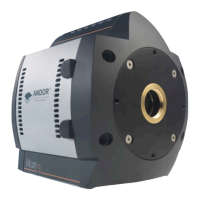Page 33
Features & Functionality
3.4 - ACQUISITION OPTIONS
3.4.1 - Capture Sequence in Frame Transfer Mode
A number of acquisition modes are available for the iXon3 range to best suit your experimental demands. In Frame
Transfer (FT) acquisition mode, the iXon3 can deliver its fastest performance whilst maintaining optimal Signal to Noise.
It achieves this through simultaneously acquiring an image onto the image area whilst reading out the previous image
from the masked frame storage area. Thus there is no time wasted during the readout and the camera operates with
what is known as a 100% ‘duty cycle’.
Step 1 Both Image and Storage areas of the CCD are fully cleaned out. This is known as a "Keep Clean Cycle". Keep Clean Cycles occur
continuously to ensure that the camera is always ready to start an acquisition when required. Further details of the keep clean cycle
are given later.
Step 2 On receipt of a Start acquisition command the CCD stops the Keep Clean Cycle. This allows the image (photoelectric charge) to
build up in the Image area of the CCD. The CCD remains in this state until the exposure time has elapsed, at which point the read-out
process starts.
Step 3 The rst phase of the readout process is to quickly shift the charge, built up in the Image area, into the Storage area. The time required
to move the charge into the Storage area is approximately calculated as follows: (No. of rows in the Image area) x (vertical shift
rate).
Step 4 Once the Image area has been shifted into the Storage area the Image area stops vertically shifting and begins to accumulate charge
again, i.e. the next exposure starts. While the Image area is accumulating charge the Storage area is being read out. This readout
phase can take tens of milliseconds to seconds depending on the image size, readout pattern and readout speed.
Step 5 On completion of the readout, the system will wait until the exposure time has elapsed before starting the next read-out (i.e. returning
to Step 3).
Figure 22: Capture
sequence (FT mode)

